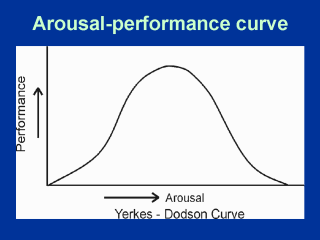| front |1 |2 |3 |4 |5 |6 |7 |8 |9 |10 |11 |12 |13 |review |
 |
How does a perceived demand-resource mismatch generate the symptoms
of “stress”? One mechanism is known as the arousal-performance (or Yerkes-Dodson)
curve (see above). This curve reflects the relationship between task performance (here the
task could be anything, from a simple learning or memorization task to carrying out a
complex procedure such as managing air traffic at a busy airport or doing a major surgical
operation, driving a car or other things) and cortical arousal. What this curve shows is that if arousal is too low, performance is poor. As arousal increases, performance improves to an optimal point. If arousal continues to increase thereafter, performance begins to deteriorate. At very high levels of cortical arousal, behaviour begins to disintegrate and coherent responses become increasingly difficult to execute. Eventually, the organism cannot manage even simple tasks that, on their own under different circumstances, were performed almost automatically, such as signing one’s name. If you think this sounds suspiciously like a stimulus or response based model, then you’re correct. Except this was not developed to explain stress. We have to explain why the arousal occurs, and of course, it is the anticipation of harm if coping is unsuccessful. One famous study, called the “Executive Monkey” study carried out in the 1970’s used an experimental design involving two monkeys. The Executive Monkey was given a button which could switch off an electric shock that would be administered to both the Executive and other monkey. The shock would occur two seconds after a buzzer sounded. The Executive monkey very quickly learned to exert control over the shock and would switch it off each time the buzzer sounded. At the end of several weeks, both animals were killed by the researchers and their stomachs examined. One animal had severe stomach ulceration and the other animal had none. Which animal do you think had the stomach ulceration? This study was one of the first to demonstrate a link between behavioural control over a threat and patho-physiological changes in tissues. Since then, hundreds of studies have demonstrated physiological arousal, from tissue changes to alteration in hormonal profiles and secretion rates occur under a range of situations where demand and control have been manipulated and the most “stressful” situations have been clearly delineated. |